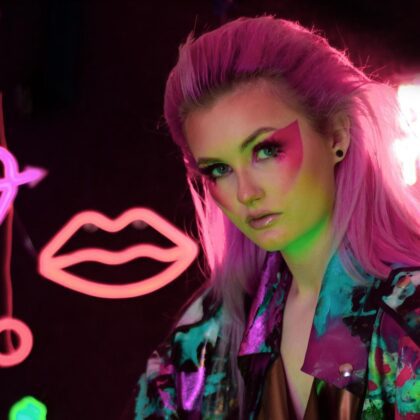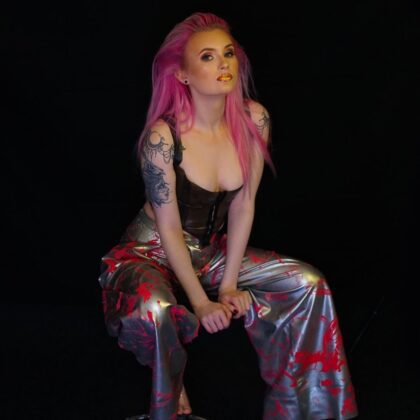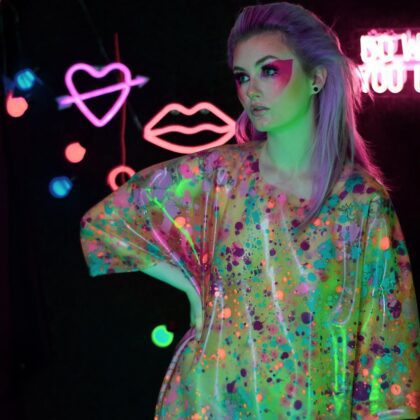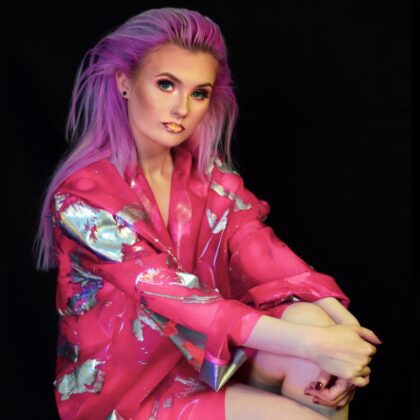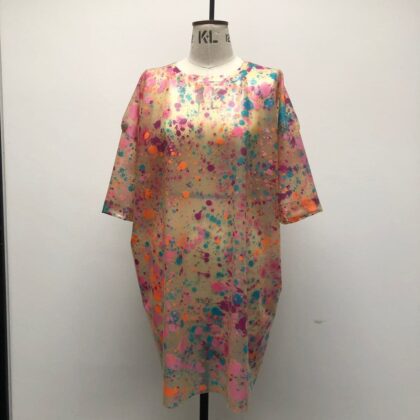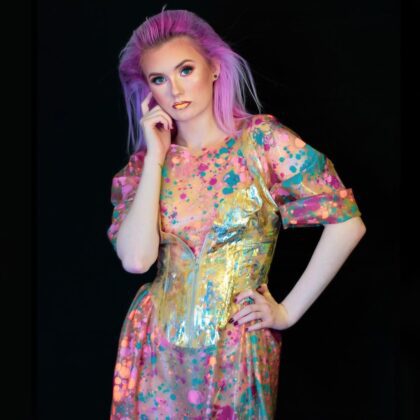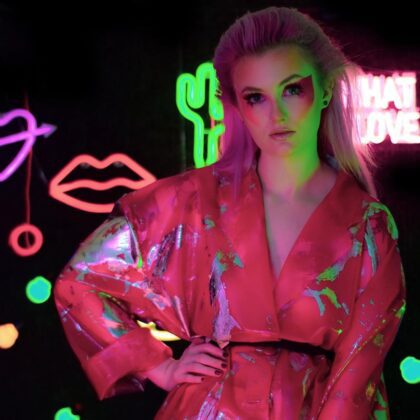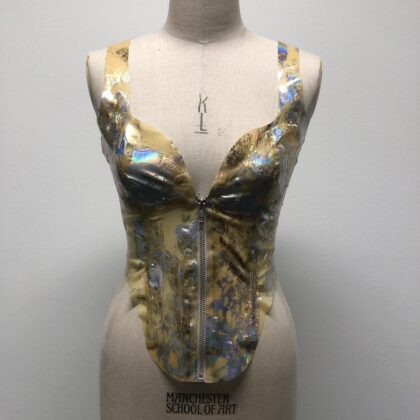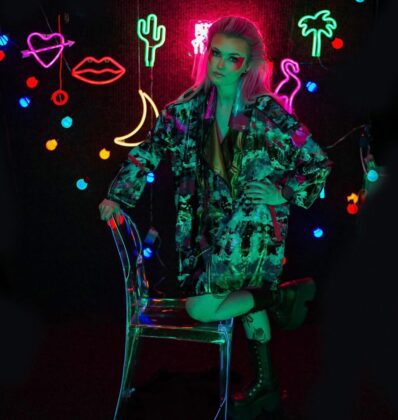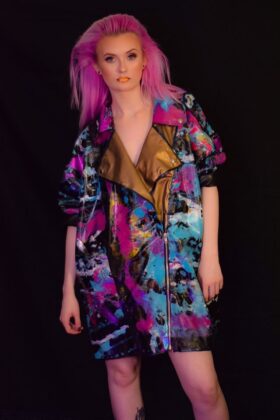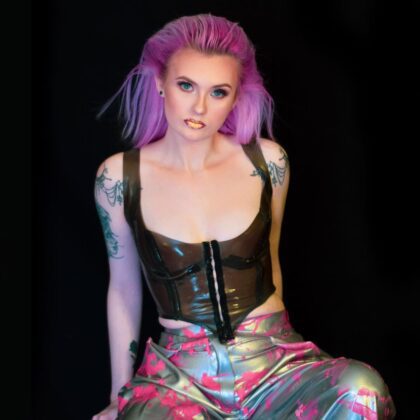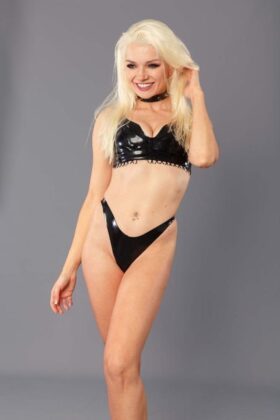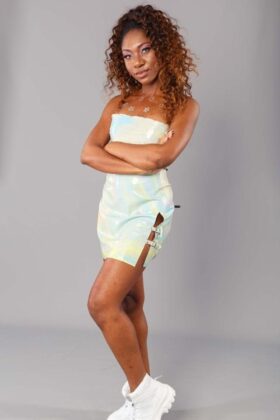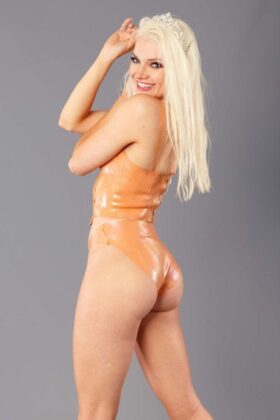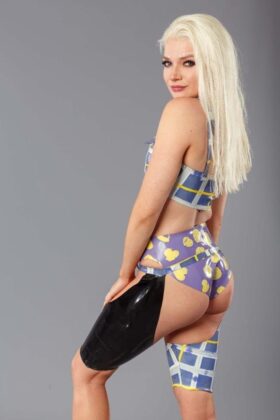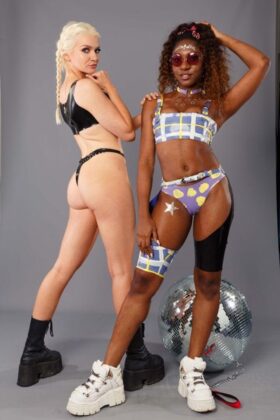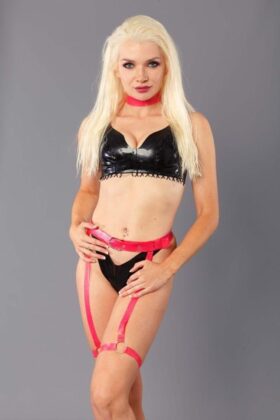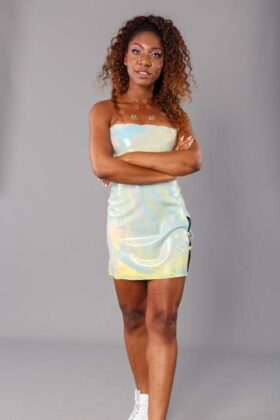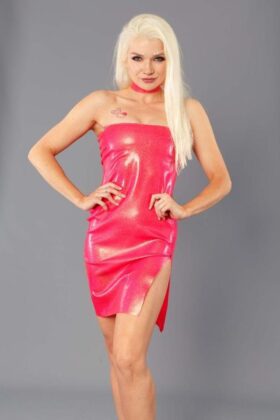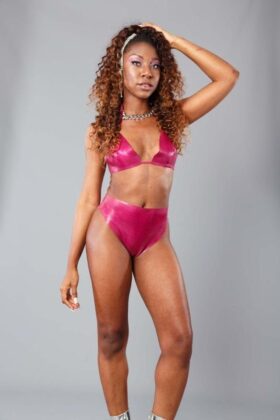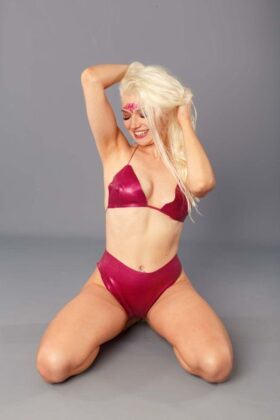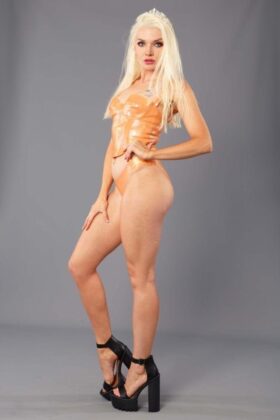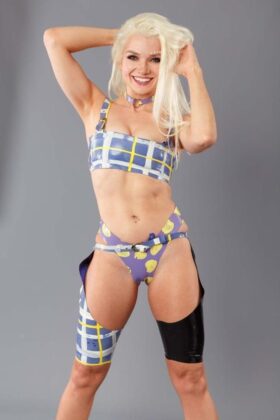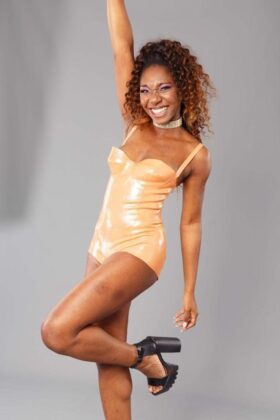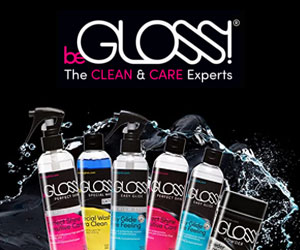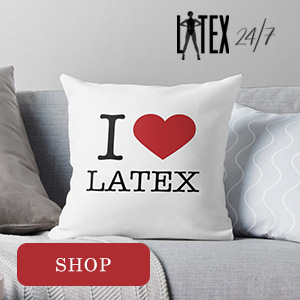Every so often a unique and exciting new latex designer enters the marketplace. Whilst many designers follow the proven design patterns and garment types, once in a while, a new brand is launched which attempts to try something new and form their own niche in the world of latex fashion. Newly launched Exalt Me are one of those looking to try something new and expand the world of latex fashion to a new market. Welcome to the first in our “up + coming” series, where we focus on new, unique and exciting latex fashion designers.
The brand has been created by multi-talented Wigan born duo, Charlotte and Hannah. We originally sat down with Charlotte back in September 2019 at the very start of the Exalt Me journey to talk about what makes her tick, her hopes and dreams for the label and how she felt she can make a unique addition to the world of latex fashion.
Q: Please provide a short overview of yourself and your background in fashion and clothing design. For example, do you have specific qualifications and training which assist you in your current trade? What previous experience of clothing design do you have? How did you get into fashion design?
A: I think I knew I wanted to be involved in fashion design from an exceptionally young age, I think I was one of those lucky kids that kind of knew what they wanted to do. I left my A-Levels to go and do a BTEC in fashion and clothing, so I was only 17 when I started. I did two years studying that and then I went straight to London. I did my BA at UCA, which gave me a degree qualification in fashion. And then alongside that, I’ve been doing placements at schools and other teaching institutes of varying amounts. So I kind of knew that was where I wanted to go. As soon as I’d finished my degree, I went straight into my training degree a couple of weeks later. I did another year of that.
Then I went into teaching. I decided, probably about three years ago, that once I’d settled into the job I knew I wanted to set up my own label. My idea was always to work part-time as a teacher and have my own business part-time. Because I do fundamentally believe that if you’re teaching something, you need to be “hands-on” at all times. There’s a lot of people that don’t do that but that’s what I wanted to do. Since then I’ve been doing my Masters, alongside my job, and to kind of get my head around exactly what my business was going to become and my niche.
Q: Has a career in fashion design always been your goal and something which you have aimed for, or did it happen out of the blue?
A: Yeah, I would say I was that sad little kid. You know, the one who rather than saying “I’m gonna be a rockstar” turns around and goes “I’m gonna make clothes!” That was always kind of what I was going to do. So yeah.
Q: You’ve mentioned previously that you have undertaken a fashion degree. How beneficial has this been, what has it taught you? What have been the highlights of your time studying?
A: I’m going to come across like a right teacher now. It’s taught me resilience! Because I think a fashion degree is genuinely one of the hardest things people can do at BA level. The sheer amount of time and effort that you need to put in. No, there’s no tests or anything like that. But the fashion industry and the creative industry as a whole are relentless. The amount of hours and determination that you have to work is never ending. Most degrees you turn up for, I don’t know eight hours worth of lectures a week then write an essay, whereas it was more get there at 9 am and don’t finish till 8 pm six days a week. And so I think resilience to the industry is the best thing it can teach you.
Q: What skills do you think are important for any fashion designer to hold?
A: Well other than resilience, there is more of a phrase – “biting your tongue”. You work with a lot of different creative professionals and they’ll all have their own vision. And often, depending on if it’s your brand if you lend your clothes out to somebody else, they’re going to be styling it in a certain way, or if you’re working for a brand or something. It’s being able to negate all the personalities and all different visions to create something amazing.
Q: What are the current fashion trends now, and to be expected in the next year or so? Do you make use of these in your own designs? If so, how? A: No I don’t, I don’t think. I think the only reason I do is a lot of my clothing is aimed at a specific genre. The brand will be for a specific market, which is festival based fashion. And I will start it there. So that has its own niche, in its aesthetic, anyway, and it’s becoming a much bigger market every year. So I think that has, in many cases, its own look. And so that’s what my work targets.
But fashion as a whole actually, you’re starting to see things that were just worn at festivals that are becoming trends in themselves. Like neon again back this year. Yes, it was a 90s revival, but it was also that it was a marry up of two. Next year, you go through the typical cycle; so Christmas is always silver and gold, summer is always a floral range, and then you go through a high colour phase. Or if you feel like you’re gonna be super different, it’ll be monochrome with one colour stuck in it. That’s the commercial market, it follows trends. Like everyone buys into what WGSN said. They’re predicting years in advance. So, yeah, I guess a little bit I tried to avoid it but there are always certain aspects you can buy into.
Q: Moving onto latex fashion, how long have you been working with latex as a material? When did you first realise you wanted to pursue working with it? What first sparked and started your interest in making latex fashion garments? How did you discover the material? Was it a personal interest or intrigue, maybe seeing celebrities wearing outfits made from latex?
A: That’s a difficult one. My first owned piece of latex clothing was when I was 16. I think the first thing I purchased was a pencil skirt. And then I got a dress the year after. This was around the days of House of Harlot and all of that. The old days as it were. But, I guess, because it wasn’t mainstream or popular I didn’t know a single other person who owned anything. And I remember being told when I wore it on a night out, “What’s that?” It looks really good because it fits well, etc. So I had, what I call an innate initial like to the stuff and I don’t really know how I came across it, to be honest. I think it was just because I was into fashion that I liked obscure materials anyway. I think that’s just where it came from.
The first time I tried to make something was my BA. So about eight years ago – it was an absolute disaster. Because I’m really slow on technology I didn’t use YouTube to try and work out how to stick it together or do it properly. And it was a mess. That was like the first time. And then I guess I’ve taught myself slowly over the years since then.
Q: Can you describe what is involved with a typical latex garment design? What influences your initial design choices? What process do you follow? How long does it typically take to come up with and produce a new item?
A: Oh, that varies drastically. If I’m making pieces for myself, for example Halloween is coming up so the perfect time so I’m making a piece for that for myself. Because that’s my idea, and it’s for me, I know in my head straight away it won’t take me that long to sketch an idea because of the number of years I’ve been patterning. I can sketch and make in less than two days if I really put my mind to it, two solid days I can get it done. And when it comes to things like my collections the longest process I think is toiling. For my MA I went through each garment and went through three toils. I guess you’re talking a week a garment, not including design stage for making. Design comes to me much more easily. I’m pretty sure a lot of designers say that. As in they have an idea and then it doesn’t take them that long to research it and start sketching. It’s once you’ve sketched it and you’ve got kind of like that hazy idea in your head of what you want. It’s refining it to make it look like you have in your head. That’s the hard bit because nine times out of ten designers will say they’re never totally happy with what they’ve got.
Q: What do you enjoy most about working with latex? What are the biggest challenges when working with the material? What has been your greatest learning experience since designing your first piece?
A: The greatest learning experience is going back, it felt like I was going back to being a child where I was first learning to pattern cut and having to work out how to do things for latex.
Specifically, because you’re classically trained in pattern cutting, its rules don’t necessarily apply to latex. So for my first full collection, the collection that I’ve done for my MA, you wouldn’t normally put a zip-fly in latex because it’s stretchy. But if you’re doing it for a fashion purpose, to give it the aesthetic, you have to work out the best way to make it look like a fully functioning working zip line. But all the little pieces that are fiddly and annoying enough in a zip-fly don’t go in the same order and they’re not cut the same way. Same as you don’t line anything that’s not latex. So I think trying to learn and create a whole new way of pattern cutting to do things just to make it look like something that already exists somewhere else was probably the hardest thing I’ve ever done.
Q: Latex fashion tends to be associated with young, athletic and toned people. Do you feel there are any limits to who can wear the material; big and small, young and old?
A: No. Some of my work recently was purposely oversized, it’s purposely massive. And yes, it’s been put on a dainty small model. However, what I was purposely trying to do in this first collection, to make my market stand out from what’s already out there, is not create “fashion collections” that are going to look like typical fetwear that’s really stretched and so on. I want it to be seen from a fashion perspective. And so it was oversized on purpose. And I think by doing that, it makes people look at the material differently and if they look at it differently they’ll associate it differently and it’ll open it to a wider market. And you know, I’ve got friends in the LGBT community who aren’t into fetish but they really liked the fabric and so on. They’re not young petite females and so on and they like it and that’s what I want to kind of inform.
Q: Moving on to the people who get to wear and see your awesome designs; how important is the reaction of your clients when they get to experience and try on their garment for the first time?
A: That is the hardest question you have given me so far because any artist wants to say no, it’s my vision. An artist might say “well that’s my vision.” A designer will say well, practicality you need it to sell. I think I sit somewhere in the middle in a sense that I want them to experience it and really enjoy it, but I want them to experience it and enjoy it from looking at a fabric that they may not have normally come across or used. And because it is in a slightly different market, not in the fetish market, and kind of see alternatives to things like vinyl.
I think garments should be used more than just once. I don’t like fad-fashion, or fast fashion markets in that sense. And I care about it from that kind of perspective that people really get on board with the fabric itself and they care about it the way I do.
Q: What is the best reaction you have ever received from someone wearing your design? What reactions have you seen, and how do those not used to latex fashion, tend to react to the use of the material and seeing it for the first time? Is it generally positive or negative?
A: The most comical version of that was quite recently, I went to a gig at The Courteeners in Manchester and I wore one of my latex corsets to that. But it was quite a commercial looking corset rather than like, you know, an oldy worldy traditional one. And one friend of a friend came along, and he saw what I was wearing. They didn’t even say anything. They just walked straight up to me and went (Charlotte pokes herself) because they just wanted to stroke it. You could see the wonder on their face, and then eventually I got out of them after a couple of minutes. “What is that? Exactly?” Because they didn’t know what it was. And they were a bit confused because they’re like, “it looks like a jellyfish that you’re wearing”. And it sparked a conversation and then we had a bit of a chat about it. And they kind of went “I was puzzled at first. But you know what? I love it”. That’s a reaction I get from a lot of people.
Q: Turning to the material itself, how versatile is latex and how easy is it to create the designs of your dreams? Do you feel it is easier or more complex to do this than with traditional materials?
A: Definitely more complex than traditional materials. So, if you’re classically trained, you learn how to work with plain fabrics; with no stretch, one-way stretch, two-way stretch, and how to work with the fabric on the bias. With latex, it stretches in every direction. Yes, it’s easier to pattern cut because there is no grainline, you can do what you fancy with it. So that makes it easier. But with that, when you actually try and create interesting patterns, like you want to create flounce or you want to create body and shape rather than fitted garments, that becomes a lot more difficult really quickly. I love the fabric but you have to get your head around it. But I think anything that is more challenging if you spend your time doing, it is going to get a better result in the end and I think that’s how latex works.
Q: What do you feel is the main appeal of latex fashion? What are your favourite elements?
A: I’m trying to think what was the appeal to me. As I say I came across it quite young and I really liked it. If you are going for a fitted look, then it definitely gives the best-fitted look that you can get because it doesn’t wrinkle, it doesn’t pull and it holds the body well without needing to wear waist trainers. So it really accentuates the body if you’re in for a fitted look but equally even if you’re not doing that it actually hangs really well. And the shine to it, I think is what attracts people from a distance and I think that’s what makes people come over and look at it. I think it’s the shine that you just don’t get with other fabrics. And the way the light reacts off it.
Q: Who or what are your biggest influences and who do you respect most in the genre of latex fashion?
A: Really, really obvious. But it’s Antidote London Latex. Just because I don’t think there are that many people who are doing fashion pieces. So Antidote is generally quite fetish, but they do a clothing line that is much higher-end stuff that the celebrities are buying that is genreing and going a little bit into fashion. They’re some of the only ones that are managing to pull off things like classic pieces of fashion; leather jackets, bomber jackets and so on. But do them to a really crisp high level in latex that makes it really appealing.
Q: Latex fashion has become more and more of a normality in mainstream thanks to the music, film and celebrity industries. Do you see this trend increasing or do you think outfits made using the material will always be a niche item? Do you feel there will ever be a day when latex garments will be mainstream and can be brought “off the peg” at normal high street stores and shops? If so, what items do you think would be included?
A: Mainly yes. I think there is one distinct issue with selling latex off the peg. One of the issues being, latex for some people, is that they’re allergic to it. There’s no getting around that. So off the peg mass-produced latex will always be in the industry fraught area of whether we should or shouldn’t do it. But as we move away from stores, so it’s not being hung up in a store anyway, it’s online and it’s easier to show care labels and information. It’s going to become way more commercial. It’s already shown that. I mentioned a bit earlier you’ve got celebrities wearing it which means House of CB, which is a commercial brand, have started selling it. And they’ve worked around the warning labels and everything like that. So yeah, I do firmly believe it’s going to become more and more commercial. Particularly if current trends, if current young fashion trends, continue to move in the direction that they are.
Q: How do you see the world of latex fashion changing over the next 5-10 years?
A: With the advances in technology, there will be a change in it. For example, to be able to change its molecular structures and make it more lightweight, or something that’s going to make it more usable for all the areas of apparel. And because it stretches in any direction. Yeah, that’s something that they’re going to want to take and look at how it works and apply it to all the fabric structures and membranes. This will allow them to make more use of the material for athletes such as divers and swimmers. Latex is really a different dynamic. So I think the properties of latex will massively change and it will be used and adapted in the way which technology allows.
Q: If you could create a latex outfit for anyone in the world, who would this be for and why? Can you give a description of the outfit you would design for them?
A: Latex is already starting to move into celebrity culture. And so I guess your idea is who would be your muse. Who do you think is going to sell it from a practical point of view. I almost don’t want to answer it from a practical point of view, but who would make you feel as though you have finally made the mainstream market. I’m just undecided as to who that person would be at this point.
I don’t do men’s wear, but being from Manchester I am absolutely obsessed with The Courteeners so I’m going to say Liam Fray in some latex. Imagine that, it would be fantastic! Haha!
Q: What do you feel are the biggest barriers for people who haven’t worn latex fashion before? What stops them from taking the plunge and wearing it? What would you say to anyone interested in wearing the material? What would be your best piece of advice for anyone who is thinking of trying to wear latex but hasn’t done so yet?
A: Even though it is becoming more associated with fashion, it’s still very much on the fringe. And so people who are maybe not fashion-forward, you know, don’t maybe have that confidence to walk down the street in it yet. So that’s one thing and I think the reason that’s the case is because earlier on it was associated with fetwear, which I have no issue with, but I think because of that it’s got a taboo attached to it – for some people anyway. And it’s coming out of that taboo but it’s only coming out of that because all taboos are becoming more open.
That’s the main thing; it’s not moving for any other reason other than taboos in themselves are becoming more open, which is why festival fashion is becoming more open and it’s moving into a fashion market because people feel they could be themselves or express themselves more at a festival. It’s almost like “I’ve wanted to do this and now I’ve got a place I’m allowed to do it.”
Q: What tips do you have for anyone who would like to include latex fashion into their “everyday” outfits? Is it possible to combine with other materials?
A: So get yourself a set of classic pieces. Classic clothing items that are made in latex. Maybe something like a biker jacket, or a pencil skirt. But wear it as if it was a night out. You’re looking for classic pieces in quite simple colours, nothing too extreme. Because the fabric itself will express itself.
Q: Coming back to your work and output, which of your designs have gained the most popularity? Are there frequent requests for particular types of garments?
A: So I’m only recently started selling so a lot of my more oversized stuff has only just gone on the market as a whole collection. Before that, I was selling targeted set pieces which are more common on the market. That’s because they are more popular. At the moment, this season, my most common piece has been a latex corset top. It’s commercial looking in the fact that it’s a corset, it’s not laced up at the back or anything. It’s just hook and eye on the front. It’s very similar to what you may have seen in the summer, that kind of thing, but made it latex, so it’s got that edge to it. That’s been my most common piece this summer.
Q: You are about to launch your own fashion design business. What was your biggest fear when going out and starting your own line?
A: I think everyone has a fear of launching and failing. I think that’s a standard fear. Niche fear for me was how I was going to juggle it with my other job and how I was going to get around the concept of the students finding out about it, questioning it and having that conversation in the classroom about “Miss makes clothes out of latex. But it’s worked out fine because it’s fashionable clothes that I’m producing, and I teach fashion so it works quite well. I think it was important to keep it quiet and produce the collection first and show the evidence of the collection. Rather than going and saying to my job “Oh I’m making latex clothes as well, by the way”, so this way I got to show them the evidence of it first.
Q: When choosing to follow your passion and start your own clothing business, why was the decision to concentrate on latex taken? Why not stick with traditional materials?
A: Simple, a fascination with it. I did try branching out. One of my favourite designers is Iris van Herpen. She’s known for all her mad stuff. She works with all sorts of materials. So I did try branching out and I did have a go at melting acrylic setting – where you use acrylic plastics and you melt them and you set them. I got very frustrated with it very quickly. It wasn’t even the complication of it, it was just so limiting in what it could do. And then I tried silicon because it has a similar aesthetic to latex but I soon got sick of that as well. It’s easier to make your own silicon than it is to make your own latex because it doesn’t have to be vulcanised or anything in the same way. But the stretch and everything doesn’t really work the same so it doesn’t really lend itself well to fashion garments.
And I guess at that point I thought I’ve tried other things, I knew what I already liked and I had proof of what I already liked. And I went straight back to it but it took me a while. I was sort of determined at one point to find something new and different. And then I was like, “Well, why am I fighting against something that I know I like and I’ve already done”, and I went back to it.
Q: What is it that drives you to continue to create new designs and collections?
A: I can’t stop it. I tried! I went into teaching, full-time teaching, and I love it. I love my job. But it’s limiting because you’re not doing your ideas. You’re kind of stifling your creative way. And so then I always end up going, “Oh, well, I need an outlet” and go and make something.. And I go back to it and end up making something again. And so yeah, I’ve never really stopped in that sense.
Q: Describe the ethos of your business, and the garments you will be designing, in three words
A: Hmmmmm, good question. Well one will have to be “festival”. One would need to be “impact”. And that’s due to, I think I’m never going to do collections in black or monochrome or even if it’s not neon, they’re going to be pretty vibrant and impactful. And the last word, “commercial”
Q: What are your short term and long term goals for your designs, output and business as a whole? Where do you see yourself in the next five years? What are your hopes and dreams for the brand?
A: The working theory at the minute is to finish my MA in the next couple weeks. I’d like to get the website up and running and be ready for the new year. At the moment I’ve only got a capsule collection, the short collection that was for submission with my brand idea. I’d like a full collection designed, and one-off pieces for photography, etc. Then a full collection by around Spring. Ready to show around May and basically full brand launch around May time. And then I’d like to tour it at certain festivals next year to begin with. And then alongside that I might show it at Berlin Fetish Week because, even though it’s not a fetish collection. Berlin Fetish Week has branched out enough that that particular show is pretty open these days. So that’s on the 24th of May that year. So my aim is to basically be fully ready to go by then.
Five years from now. I think I’ve spent the last two years getting to this point. And then I’ve got to this point and I know where I want to be in 12 months. At that point, I’ll probably do my five-year plan once the business is all up and running and sorted.
Q: Now that you are about to launch your first collection, please tell us about the themes of the collection. What design elements does it include? Where has your inspiration been drawn from? How many pieces are in the collection?
A: I’m really big on pattern colour. And so my current collection has, it’s called “gestural abstraction”, which is another term for “action painting”, which Jackson Pollock created. It’s that kind of freedom of expression that I was trying to capture on the garments as a pattern because I think that’s what latex needs to be, it needs to be a freedom of expression. So I was trying to capture the design in the pattern to say that and in some ways, some of the parts of the garments end up quite reminiscent of pride actually! That was really nice because that hadn’t been my intention at all but I’ve had comments since asking “did you design this for pride or for that community?” I was like, not at all, didn’t even cross my mind at the time. I think that will continue to be a theme. Whatever I design, I think it will be very bold in pattern, bold in colour and it will be very exuberant to kind of express yourself.
I don’t want to put myself in that bracket of “the dress designer”. I think for it to be an authentic fashion collection each collection is going to need certain garments in it to hold it together in that sense. So yes, there will be dresses, yes, there will be corsets, but there will be trousers in these collections. There will be oversized denim jackets, but they won’t be denim. To ground it, to make the collection more cohesive. Yeah, there will be everything.
Given the worldwide pandemic throughout 2020, Exalt Me chose to delay the launch of their label. We caught up with the brand recently to find out what has changed over at Exalt Me and what this extra time has allowed the label to accomplish.
Latex24/7: Thanks for speaking to us again and giving us a bit of an update on where you are with the label, the business and the collection.
Q: The brand has already grown, since we last spoke, with the recent addition of a new member to the team?
Charlotte: It has indeed! But that’s not the only thing that has changed. We’ve rebranded, created a whole new image whilst still keeping the festival feel, built our website and we are ready to launch our brand new collection. The decision was taken to push back the launch of Exalt Me as the focus moved to more pressing matters at the time. The label was instrumental in the formation of the “Wigan Scrub Hub”, a volunteer-run scheme set up by myself and my friend Hannah which made essential PPE equipment for local NHS hospitals and key workers. As a team, we completed a grand total of 1823 sets, 969 bags and 426 hats. Pretty incredible for a team of volunteers. We were even featured on the BBC as Stacey Dooley interviewed us for the show ‘Lockdown Heroes’ (currently available on BBC iPlayer at https://www.bbc.co.uk/programmes/p08bbbxh). The Scrub Hub was the first time myself and Hannah had ever worked together in business and realised we make a great team, so we decided to join forces to create what Exalt Me is today. It’s come a long way in such a short period of time and we absolutely love it.
Hannah: I’m super excited we have created Exalt Me. As Charlotte said we make a great team. Charlotte still deals with the design and manufacture of the garments, and I deal with the business side of things; so business plans, strategic plans, as well as the brand concept, marketing and website and even the logistics.
Q: What has this allowed you to achieve? How did you think it will benefit the brand?
Hannah: We both have different skill sets to bring to the brand and I think that gives us a key advantage which the business didn’t have before.
Charlotte: Totally agree.
Hannah: This has freed up Charlotte to concentrate on creative and design elements of the collections, whilst I can deal with the back-office tasks, branding and marketing. Dividing those tasks between two people can only help the brand grow as we’ve effectively doubled the time available. Any fashion brand is built both on its collections and its reputation, and these are equally as important to us. Having two heads has got to be better than one!
Q: When do you plan to formally launch the brand and your collection?
Charlotte: August 1st is our new full launch date, that’s when the website will officially be live. It will be available over at www.exaltme.co.uk
Q: That’s fantastic to hear. Why launch the label now?
Charlotte: We think it’s fair to say that plans for every business in 2020 have been altered, or put on hold. The majority of the festival season in 2020 has had to be cancelled. Given that festival latex fashion is the core of Exalt Me, a key area of our marketplace was not available.
Hannah: That being said, there is nothing stopping anyone from wearing our designs to summer parties and events right now, even in Ibiza too now we can travel again. Launching in August allows us to start the process of growth, publicity and generally “getting the brand name out” in preparation for the festival season in 2021. This will mean we can get the roots of our business sorted in 2020 and start to produce orders straight away before next year’s festival season kicks in.
Q: Where did the name “Exalt Me” come from?
Hannah: Like any fashion brand we wanted a name which was not only unique and dynamic but also gave the public an idea of our ethos. The word “Exalt” means to “raise to a higher rank or position” and this is how we want our customers to feel when wearing our garments; to feel empowered and unshackled from traditional trends and conventions and something that can become synonymous with our brand. Also, you’ll probably notice the word “Exalt” is an anagram of “Latex”.
And who are we to argue with that!
This new, exciting, latex fashion label has launched TODAY so be sure to head over to www.exaltme.co.uk to check out their amazing new collection – available NOW.
Also, be sure to follow Exalt Me over on Instagram to be kept up to date with this new and upcoming brand.
Don’t forget you can check out many other interviews with designers, models and photographers over at the Latex24/7 Interviews.
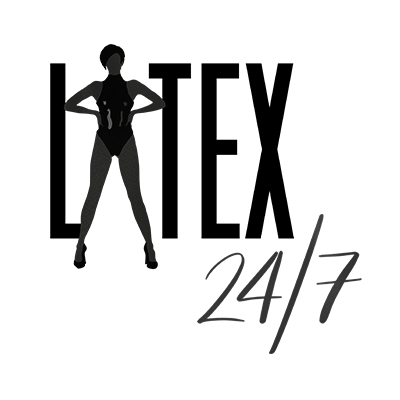
We’re here, around the clock, bringing you the latest and greatest celebrity, designer, blogger, vlogger and modelling latex fashion news and reviews from around the world. If it’s shiny then we’ll be covering it!

















